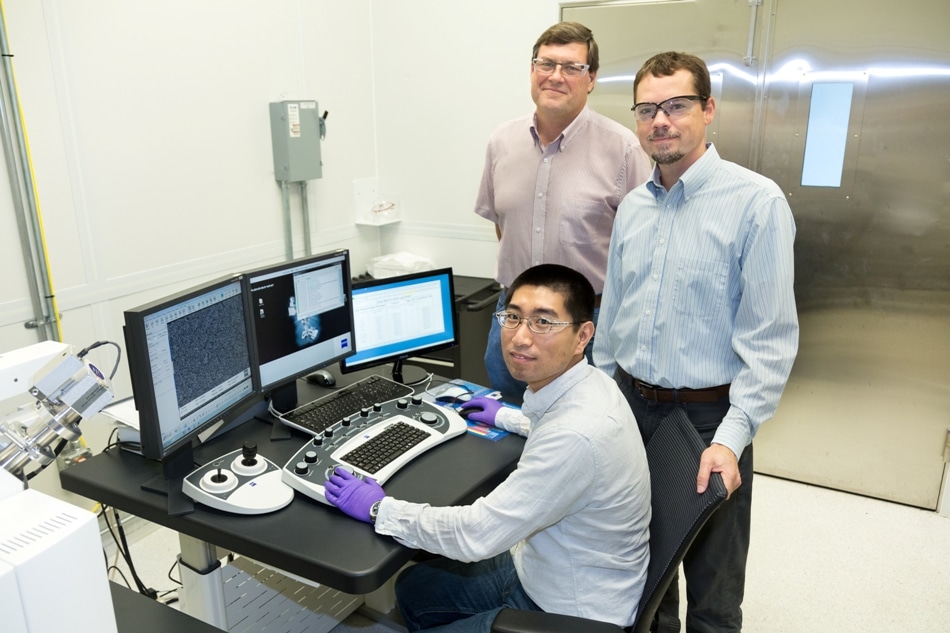Oct 13 2016
 ORNL's Yang Song (seated), Dale Hensley (standing left) and Adam Rondinone examine a carbon nanospike sample with a scanning electron microscope. (CREDIT: ORNL)
ORNL's Yang Song (seated), Dale Hensley (standing left) and Adam Rondinone examine a carbon nanospike sample with a scanning electron microscope. (CREDIT: ORNL)
Researchers at the Department of Energy’s Oak Ridge National Laboratory have devised an electrochemical process that uses miniature spikes of copper and carbon to convert the common greenhouse gas carbon dioxide into ethanol. Their process involves catalysis science and nanofabrication and their finding happened by chance.
We discovered somewhat by accident that this material worked. We were trying to study the first step of a proposed reaction when we realized that the catalyst was doing the entire reaction on its own.
Adam Rondinone, ORNL
The study is published in ChemistrySelect.
A catalyst composed of copper, carbon and nitrogen was used by the team. They applied voltage to set off a complex chemical reaction that fundamentally reverses the combustion process.
Using the nanotechnology-based catalyst which has several reaction sites, the solution of carbon dioxide dissolved in water converted into ethanol with a yield of 63%.
Normally, this sort of electrochemical reaction produces a mix of many different products in small quantities.
“We’re taking carbon dioxide, a waste product of combustion, and we’re pushing that combustion reaction backwards with very high selectivity to a useful fuel,” Rondinone said. “Ethanol was a surprise -- it’s extremely difficult to go straight from carbon dioxide to ethanol with a single catalyst.”
The catalyst’s uniqueness is in its nanoscale structure, comprising of copper nanoparticles set in in carbon spikes. This nano-texturing method avoids the need to use expensive or rare metals such as platinum, which restrict the economic feasibility of several catalysts.
By using common materials, but arranging them with nanotechnology, we figured out how to limit the side reactions and end up with the one thing that we want.
Adam Rondinone, ORNL
The researchers’ preliminary investigation indicates that the spiky textured surface of the catalysts offers sufficient reactive sites to enable conversion of carbon dioxide to ethanol.
“They are like 50-nanometer lightning rods that concentrate electrochemical reactivity at the tip of the spike,” Rondinone said.
The researchers believe that their method can be scaled up to industrial applications as the method relies on inexpensive materials and has the ability to function at room temperature in water. For example, the technique could be used to accumulate excess electricity produced from variable power sources such as solar and wind.
A process like this would allow you to consume extra electricity when it’s available to make and store as ethanol. This could help to balance a grid supplied by intermittent renewable sources.
Adam Rondinone, ORNL
The team plans to tweak their method to optimize the overall production rate and further analyze the behavior and properties of the catalyst.
ORNL’s Yang Song, Rui Peng, Dale Hensley, Peter Bonnesen, Liangbo Liang, Zili Wu, Harry Meyer III, Miaofang Chi, Cheng Ma, Bobby Sumpter and Adam Rondinone are coauthors on the study. The study has been published as “High-Selectivity Electrochemical Conversion of CO2 to Ethanol using a Copper Nanoparticle/N-Doped Graphene Electrode.”
The research received supported from DOE’s Office of Science and used resources at the ORNL’s Center for Nanophase Materials Sciences, which is a DOE Office of Science User Facility.
Nano-spike catalysts convert carbon dioxide directly into ethanol
ORNL researchers develop a nano-spike catalyst that converts carbon dioxide directly into ethanol. (CREDIT: ORNL)